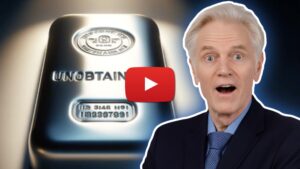In a time of mounting debt, rising interest payments, and inflationary pressures, some in financial and policy circles are floating a bold solution: revalue the U.S. government’s gold reserves. In a recent episode of the GoldSilver Show, Mike Maloney and Alan Hibbard break down what gold revaluation really means — and why it might not be the silver bullet some hope for.
Here’s a deeper look into the most eye-opening parts of the discussion.
What Does “Revaluing Gold” Mean — And Why Now?
The U.S. Treasury holds over 261 million troy ounces of gold, but it values them at just $42.22 per ounce — a price set in the 1970s. With gold now trading above $3,000, that official valuation is wildly outdated.
A recent paper published on the Federal Reserve’s website explores the idea of bringing the book value of gold closer to market value. Doing so, even as a simple accounting change, could give the Treasury a windfall of hundreds of billions of dollars—at least on paper. The idea has precedent: countries like Germany, Italy, and Lebanon have tried similar revaluation tactics to reduce their debt loads.
The Real Numbers: Can Gold Revaluation Move the Needle?
Mike and Allan dig into an Excel model that asks two questions:
- How much would gold need to be revalued to make a dent in the U.S. debt-to-GDP ratio?
- Could revaluation reduce exploding interest payments on the debt?
The results are sobering.
- To lower the debt-to-GDP ratio from 119% to just 116%, gold would need to be revalued to about $3,981 per ounce — higher than today’s market price.
- To get to the “sustainable” 90% debt-to-GDP level, the gold price would need to hit $34,000 per ounce.
- To return to 2007 levels (before the global financial crisis)? Try $86,000 an ounce.
In other words, revaluing gold at current or even moderately elevated prices doesn’t make much of a dent. And going high enough to matter would risk destabilizing the global financial system.
The Interest Payment Problem
Perhaps even more troubling than the debt itself is the interest on it. In just five years, annual interest payments have more than doubled—from around $500 billion to over $1.1 trillion. With average rates trending upward, the cost of refinancing the debt continues to climb.
Allan’s model shows that to reduce annual interest payments meaningfully — say, from $1.1 trillion to pre-COVID levels — the government would need to revalue gold to $64,000–$77,000 per ounce. And to eliminate interest payments entirely? Over $138,000 an ounce.
Clearly, this isn’t a scalable or realistic solution.
Gold Isn’t the Fix — But It Might Still Be a Signal
While a gold revaluation could provide some short-term accounting relief, it’s not a viable path to fiscal recovery. The numbers required are simply too extreme. But as Mike and Allan point out, the mere fact that this idea is being seriously discussed by central banks and financial publications signals just how fragile the current system has become.
If you’re looking for a deeper understanding of the debt crisis, the limits of monetary policy, and gold’s evolving role in global finance, this video is a must-watch.
P.S. Don’t forget: You can earn up to $2,000 in bonus silver when you open a GoldSilver vault account. Learn more here.
Get Gold & Silver Insights Direct to Your Inbox
Join thousands of smart investors who receive expert analysis, market updates, and exclusive deals every week.








